Contents
Market Overview
Macro Review
A dark week for global peace. Russia’s recognition of Donetsk and Luhansk People’s Republic drew a similar comparison to Georgia’s Abhazia and South Ossetia in August 2008 and Crimea in March 2014. The Georgian occupation was short-lived and while the occupation in Ukraine is uncertain, a path forward for further dialogue is possible. Clearly weekend developments will define history. In the immediate aftermath of Thursday’s invasion, we saw Russian equities fall 38% with MOEX briefly suspending trading and introducing a short-sale ban. Given that offshore USDRUB had traded to 89 before the Moscow open, the onshore ‘open’ was notably volatile and the Central Bank of Russia (CBR) intervened to support the currency. The CBR also eased prudential regulation allowing banks to revalue financial assets using the FX rate on February 18th. The Russian insurance premia, measured by 5-year CDS, rose by some 450bp and trade at 925bp when it started 2022 earlier in the year at just 125bp. That is the highest spread since the GFC in 2008 and well above the highs seen in the annexation of Crimea in 2014. Needless to say, most of the sovereign weakness from Thursday was offset with a strong rebound on Friday, as Russian equity and credit sharply rallied. The intensity of the sell-off was in part offset by the dip-buying mentality, where diplomacy is the next major catalyst. We continue to see investors remain underweight Russian credit, but overweight Ukraine, meaning that technicals are driving the market. The impact of sanctions was largely muted, with each of the three rounds from the U.S., EU and UK considered tepid and failed to put the Russian government under any material pressure. The only exception is that Germany will no longer certify Nord Stream 2 and the U.S. sanctioned the construction entity behind it. Meanwhile, Fed fund futures initially priced out a second 25bp hike, although settled at 26-32bp for the next FOMC meeting as it seemed that Putin was briefly bailing out Chair Powell. While this has clearly been a historical moment, the impact on global EM was limited, insofar as a contagion event. The combined index weights of Russia and Ukraine in the EMBI is 5.4%, CEMBI 4.7% and GBI-EM index is 6.8%. These are average index weights in 2022, because as prices fall the weights become smaller.
EM Credit Update
Emerging market sovereign credit ended the week down 4.8%, with credit spreads widening 56bp. Outperformers over the week were Kuwait, Qatar and Saudi Arabia, while Ukraine, Belarus and Russia underperformed as one would have expected. There was further weakness in Sri Lanka, Zambia and Ghana, although beyond that the market held up in good order.
The Week Ahead
Developments in Ukraine will clearly be the main priority of next week. The response from OPEC+, along with the progress around the renewed Iran nuclear deal will also be high on the agenda given crude oil’s brief ascent above $100/bbl. Thereafter, President Biden’s State of the Union speech will be key (Tuesday), just as Chair Powell testifies in front of House Services Committee (Wednesday) and Senate Banking Committee (Thursday). These events fall before the non-farm payrolls release on Friday, although China’s manufacturing PMI could dip below 50 and create a headline. Aside from the RBA decision, EM interest rate updates are limited to just Malaysia (1.75%) and Ukraine (10.0%). Finally, the inflation schedule is picking up with releases from Indonesia, Peru, Philippines, Sri Lanka, Thailand and Turkey.
Highlights from emerging markets discussed below include: Russia invades Ukraine, appears to target “regime change” in Kyiv; South Africa presents 2022 budget; mostly sufficient for near-term sentiment; and China unsurprisingly fails to condemn Russian attack but urges restraint of all parties; PBoC liquidity injection in line with easing cycle underway.
Fixed Income
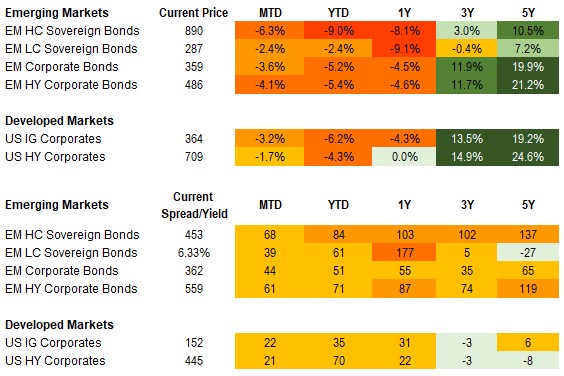
Equities
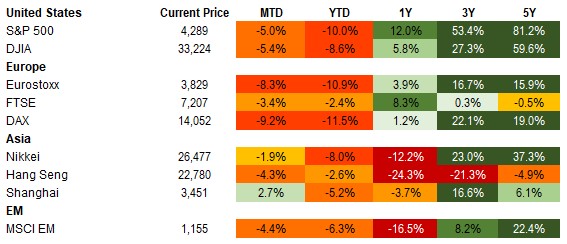
Commodities

Source for data tables: Bloomberg, JPMorgan, Gramercy. EM Fixed Income is represented by the following JPMorgan Indicies: EMBI Global, GBI-EM Global Diversified, CEMBI Broad Diversified and CEMBI Broad High Yield. DM Fixed Income is represented by the JPMorgan JULI Total Return Index and Domestic High Yield Index. Fixed Income, Equity and Commodity data is as of February 25, 2022 (mid-afternoon).
Emerging Markets Weekly Highlights
Russia invades Ukraine, appears to target “regime change” in Kyiv
Event: After months of diplomatic efforts to stem a Russian military attack against Ukraine and an abrupt change in tone/message by the Kremlin at the end of last week, Russia launched what appears to be a full-scale invasion targeting regime change in Kyiv and installing of a pro-Russian government.
Gramercy Commentary: In our previous commentary on this topic, we wrote that this week would be decisive in tensions between Russia and the West over Ukraine. Developments took a sharp turn toward a military escalation scenario when it became clear that Russian troops will remain in Belarus after drills there concluded and President Putin recognized the independence of the two pro-Russian separatist controlled enclaves in Eastern Ukraine, the Donetsk and Luhansk People’s Republics (DPR and LPR). Amid enormous uncertainty and active fighting across Ukraine, at the time of writing, including at the outskirts of Kyiv, Ukraine’s capital, a wide range of potential outcomes in the current situation are possible. Packages of major and coordinated sanctions have been unveiled by Western powers targeting key elements of the Russian economy and its international links, which could have significant negative implications over the medium-term. Higher global energy prices and possible countersanctions by Russia involving gas/oil exports to Europe could have meaningful macroeconomic impacts globally, including on the outlook for developed markets’ monetary policy. On the geopolitical level, Russia’s aggressive step in Ukraine could mark the beginning of a complete rupture in the Russia-West political relationship if Putin remains in power – a period akin to a new “Cold War”. For Ukraine, the foremost question at this stage is in what form would sovereignty be preserved and would Russia attempt to install a pro-Kremlin puppet regime in Kyiv. Some possible scenarios could include a partition of the country along a West-East divide, government in exile, and/or a protracted insurgency against a Russia-backed regime. While all these profound uncertainties play out, markets are likely to be volatile on the Russia/Ukraine complex until some level of clarity on the “day after” arrangements start to emerge.
South Africa presents 2022 budget; mostly sufficient for near-term sentiment
Event: Finance Minister, Godongwana unveiled solid fiscal performance for FY 2021/22 with the consolidated fiscal deficit of 5.7% of GDP about 2% of GDP better than outlined in the Medium-Term Budget Statement (MTBS) in October, albeit generally in line with consensus expectations. The improvement was in large part driven by stronger revenue performance on the back of better profits of mining and manufacturing companies. For 2022/23, the authorities are targeting a slightly wider fiscal deficit at 6% of GDP relative to FY 21/22, with a real GDP growth assumption of 2.1%, primary balance by FY 2023/24, and debt stabilization at around 75% of GDP in 2024/25 (vs. 78% of GDP in the October MTBS). Weekly domestic SAGB issuance is likely to be slightly more than markets expected at just over R5bn.
Gramercy Commentary: We see the budget as adequate for the short-term, with confirmation of conservative spending execution on the back of robust revenues last fiscal year and avoidance of a material fiscal thrust this coming fiscal year and over the medium-term. We see some downside risk to this FY’s growth assumption and revenue estimates in the outer years, but in the backdrop of still very elevated commodity prices and only marginally higher domestic issuance this year, we see the budget as relatively benign for SAGBs. Broader risk sentiment and challenges around the fast-moving geopolitical situation will likely temporarily outweigh local factors in the coming days and weeks. With that being said, total direct goods trade between Russia and South Africa is marginal at about $1bn or 0.3% of GDP.
China unsurprisingly fails to condemn Russian attack but urges restraint of all parties; PBoC liquidity injection in line with easing cycle underway
Event: After Chinese Foreign Minister Wang Yi stated that sovereignty and territorial integrity should be protected late last week, Chinese authorities failed to condemn Russia’s invasion of Ukraine and instead conveyed a message of restraint of all sides, in line with the approach they took in 2014. This follows comments on Wednesday from China’s Foreign Ministry Chief Spokesperson, Hua Chunying, that criticized the U.S. for supporting Ukraine and creating panic over warfare. Meanwhile, on Thursday, a Chinese fighter aircraft reportedly temporarily breached Taiwanese defense airspace. In response to this week’s market volatility and month-end liquidity conditions, the PBoC provided just under $46bn in liquidity to the financial system via 7-day reverse repo agreements.
Gramercy Commentary: We view the Chinese response to Russia’s invasion of Ukraine as an attempt to maintain the increasingly close partnership between Russia and China. While it is not our base case for China to take actions that blatantly violate U.S. sanctions or provoke the U.S., given its desire to maintain stability in a politically sensitive year, we do not rule out developments that increase tensions and incrementally bring forward latent risks regarding Taiwanese independence. These developments could include increased frequency of Chinese military incursion into Taiwanese defense airspace in the near-term, which have been a common occurrence in recent years, or deepening of China’s strategy for unification likely outlined as part of the Party Congress in October. This, combined with prospects for China as a foreign policy issue to grow as a political talking point for the midterms in the U.S., could give rise to greater headline risk as the year progresses. With that being said, Taiwan is of great geopolitical and economic importance to the U.S. as its critical to the semiconductor supply chain and key to the American security alliance in the region, driving high U.S. interest for protection and elevating risks for Chinese escalation. From a macro policy perspective, we continue to expect gradual easing of monetary and fiscal conditions with periodic liquidity injections during times of volatility as well as prospects for further rate reductions if economic data disappoint as authorities aim to support growth.
Emerging Markets Technicals
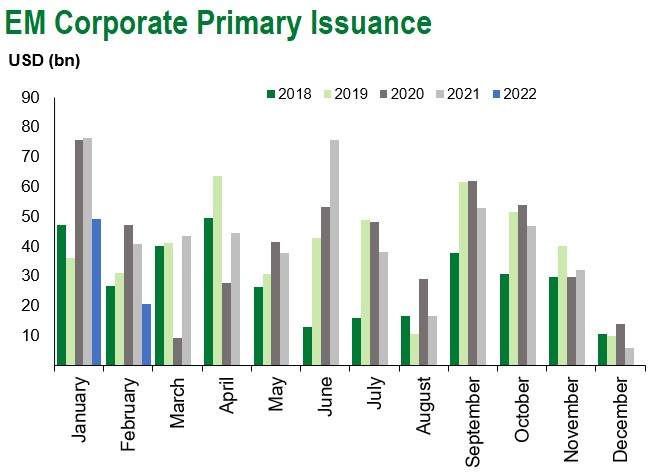
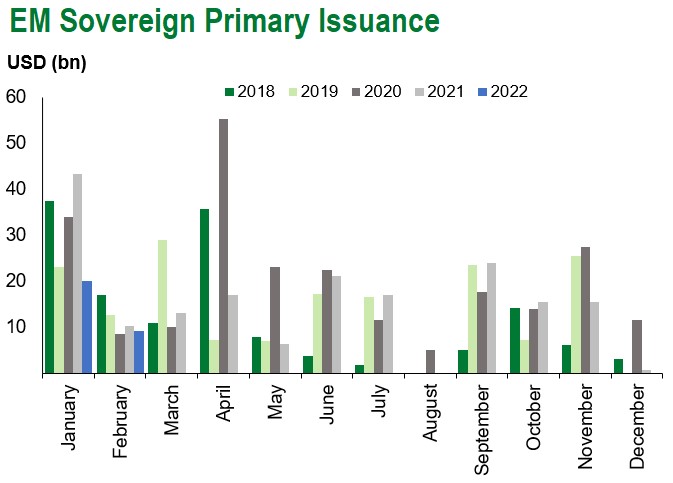
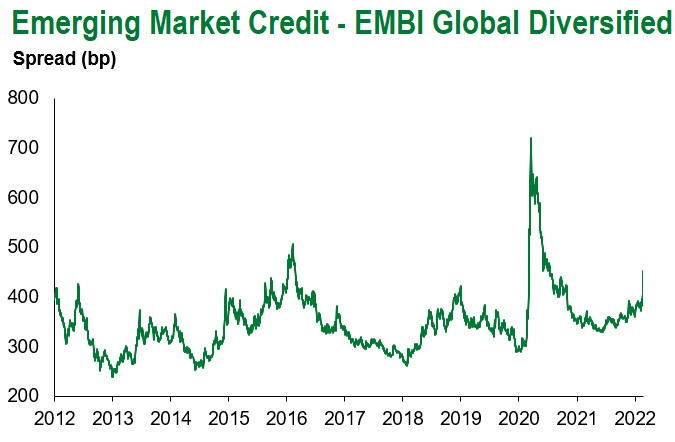
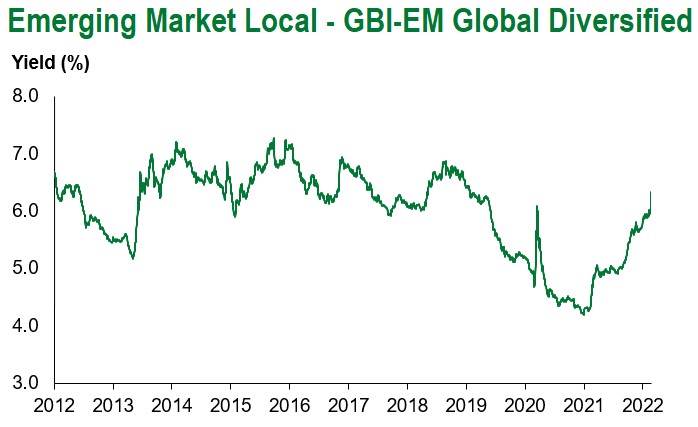
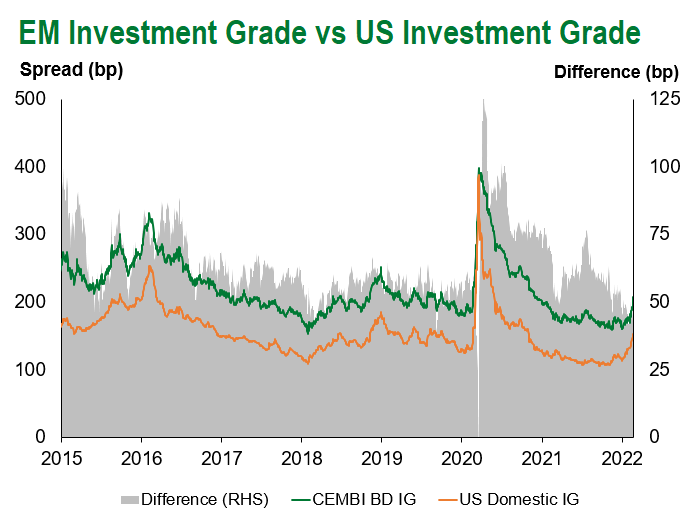
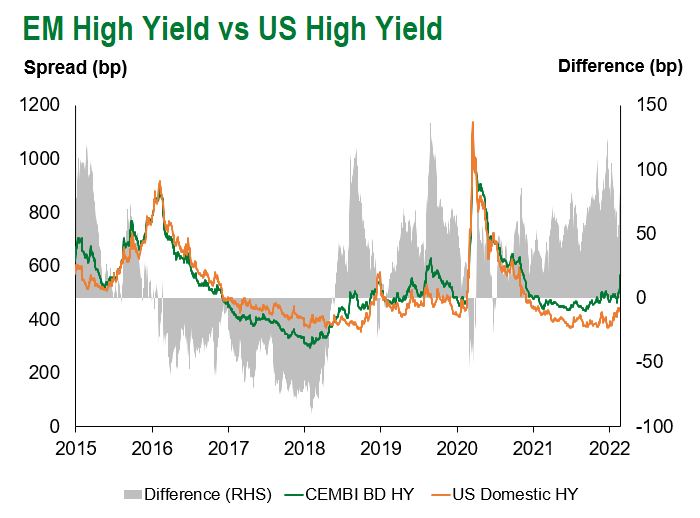
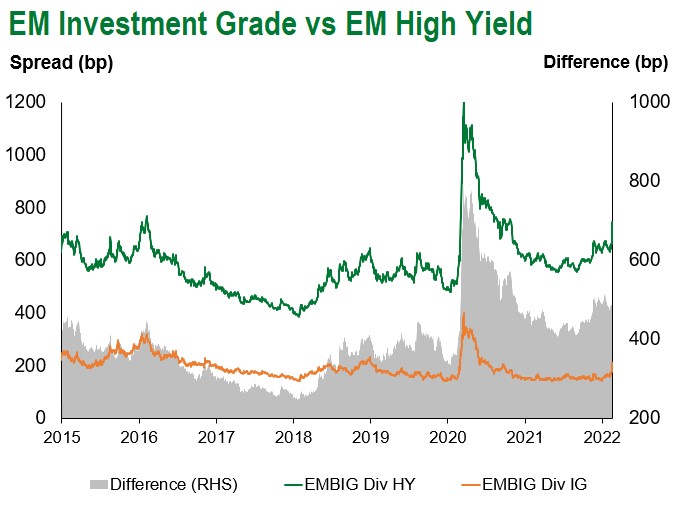
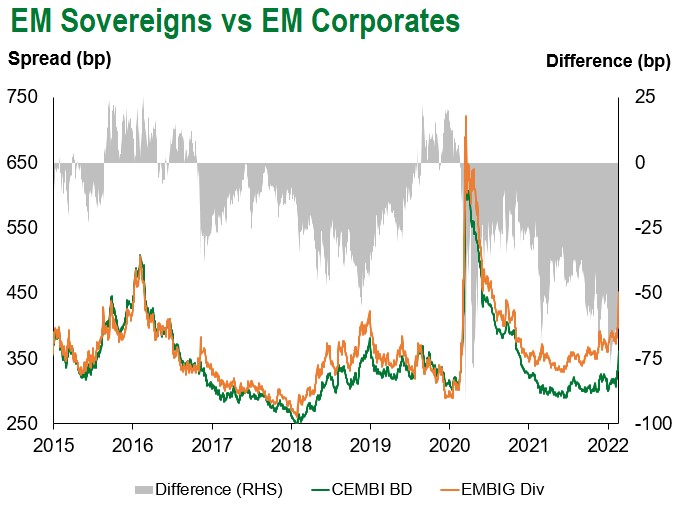
Emerging Markets Flows
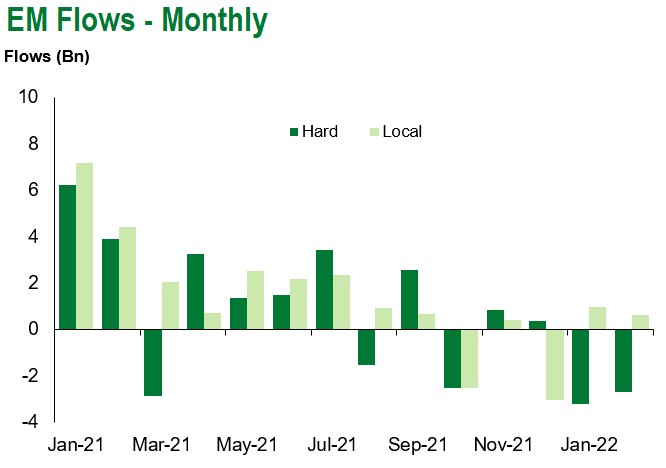
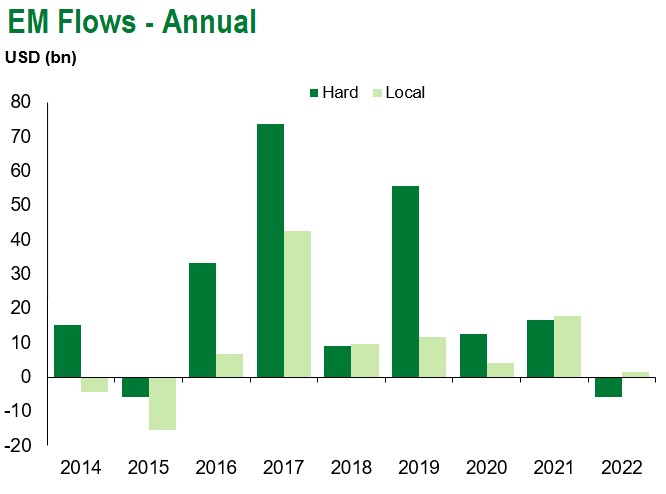
Source for graphs: Bloomberg, JPMorgan, Gramercy. As of February 25, 2022.
COVID Resources
Emerging Markets COVID-19 Case Summary
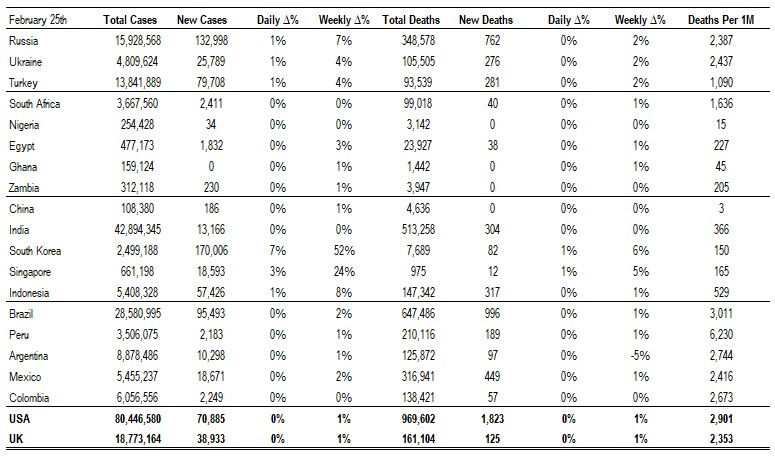
Source: Worldometer as of February 25, 2022.
Additional Crisis Resources:
Johns Hopkins COVID-19 Case Tracker
For questions, please contact:
Kathryn Exum, CFA ESG, Senior Vice President, Sovereign Research Analyst, [email protected]
Petar Atanasov, Senior Vice President, Sovereign Research Analyst, [email protected]
Tolu Alamutu, CFA, Senior Vice President, Corporate Research Analyst, [email protected]
James Barry, Vice President, Corporate Research Analyst, [email protected]
This document is for informational purposes only. The information presented is not intended to be relied upon as a forecast, research or investment advice, and is not a recommendation, offer or solicitation to buy or sell any securities or to adopt any investment strategy. Gramercy may have current investment positions in the securities or sovereigns mentioned above. The information and opinions contained in this paper are as of the date of initial publication, derived from proprietary and nonproprietary sources deemed by Gramercy to be reliable, are not necessarily all-inclusive and are not guaranteed as to accuracy. This paper may contain “forward-looking” information that is not purely historical in nature. Such information may include, among other things, projections and forecasts. There is no guarantee that any forecasts made will come to pass. Reliance upon information in this paper is at the sole discretion of the reader. You should not rely on this presentation as the basis upon which to make an investment decision. Investment involves risk. There can be no assurance that investment objectives will be achieved. Investors must be prepared to bear the risk of a total loss of their investment. These risks are often heightened for investments in emerging/developing markets or smaller capital markets. International investing involves risks, including risks related to foreign currency, limited liquidity, less government regulation, and the possibility of substantial volatility due to adverse political, economic or other developments. The information provided herein is neither tax nor legal advice. Investors should speak to their tax professional for specific information regarding their tax situation.